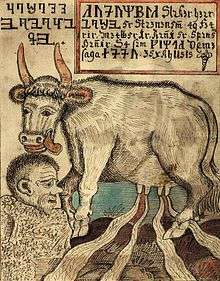Búri
In Norse mythology, Búri (Old Norse 'producer, father')[1] is an early ancestor of the Æsir. Búri was licked free from salty rime stones by the primeval cow Auðumbla over the course of three days. Búri's background beyond this point is unattested, and he had a son, Borr, by way of an unknown process. Búri is attested in the Prose Edda, composed in the 13th century by Icelander Snorri Sturluson. The Prose Edda includes a quote from a 12th-century poem by skald Þórvaldr Blönduskáld that mentions the figure. Búri's mysterious origins are the subject of scholarly commentary and interpretation.

Attestations
Buridava was a fort and sanctuary in the Roman province of Dacia on the Danube.
Búri receives mention twice in the Prose Edda—once in Glyfagining and again in a skaldic poem quoted in Skáldskaparmál. The Gylfaginning section reads as follows:
|
Hon sleikti hrímsteinana er saltir váru. Ok hinn fyrsta <dag> er hon sleikti steina, kom ór steininum at kveldi manns hár, annan dag manns höfuð, þriðja dag var þar allr maðr. Sá er nefndr Búri. Hann var fagr álitum, mikill ok máttugr. Hann gat son þann er Borr hét. [2] |
She licked the ice-blocks, which were salty; and the first day that she licked the blocks, there came forth from the blocks in the evening a man's hair; the second day, a man's head; the third day the whole man was there. He is named Búri: he was fair of feature, great and mighty. He begat a son called Borr[.] – Brodeur's translation |
Búri is mentioned nowhere in the Poetic Edda and only once in the skaldic corpus. In Skáldskaparmál Snorri quotes the following verse by the 12th century skald Þórvaldr blönduskáld:
|
Nú hefk mart |
|
Notes and citations
- Simek (Simek 2007:47).
- "Normalized text of R". Archived from the original on 2008-01-05. Retrieved 2005-07-23.
- "Finnur Jónsson's edition". Archived from the original on 2008-03-06. Retrieved 2005-07-23.
References
- Ásgeir Blöndal Magnússon (1989). Íslensk orðsifjabók. Reykjavík: Orðabók Háskólans.
- Brodeur, Arthur Gilchrist (transl.) (1916). The Prose Edda by Snorri Sturluson. New York: The American-Scandinavian Foundation. Available online at Google Books.
- Eysteinn Björnsson (ed.) (2005). Snorra-Edda: Formáli & Gylfaginning : Textar fjögurra meginhandrita. https://web.archive.org/web/20080611212105/http://www.hi.is/~eybjorn/gg/
- Faulkes, Anthony (transl.) (1987). Edda. London: J. M. Dent. ISBN 0-460-87616-3.
- Finnur Jónsson (1931). Lexicon Poeticum. København: S. L. Møllers Bogtrykkeri.
- Finnur Jónsson (1912–15). Den norsk-islandske skjaldedigtning. København: Den arnamagnæanske kommission. Edition of Þórvaldr's fragments available at https://web.archive.org/web/20080306035446/http://www.hi.is/~eybjorn/ugm/skindex/tblond.html.
- Lindow, John (2001). Norse Mythology: A Guide to the Gods, Heroes, Rituals, and Beliefs. Oxford University Press. ISBN 0-19-515382-0
- Simek, Rudolf (2007) translated by Angela Hall. Dictionary of Northern Mythology. D.S. Brewer. ISBN 0-85991-513-1
External links
- MyNDIR (My Norse Digital Image Repository) Illustrations of Búri from manuscripts and early print books. Clicking on the thumbnail will give you the full image and information concerning it.